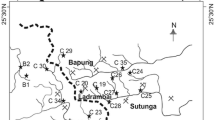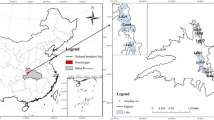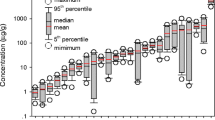Abstract
Purpose
Heavy metals from coal mines migrate into rivers and cause a severe impact on the health of local residents utilizing these rivers as a water source. However, current studies on coal mine brownfields have yet to thoroughly investigate river-associated heavy metals produced by coal mining. Therefore, this study aims to explore the distribution and risk assessment of heavy metals, namely Cr, Cu, Mn, Ni, Pb, and Zn, in overlying water, porewater, and sediments of the Yongding River, China.
Materials and methods
Overlying water, porewater, and sediments were sampled at 11 sites along the Yongding River. Heavy metal concentrations were determined through ICP-MS, and sediments were subjected to a three-step sequential extraction procedure to verify the behavior of heavy metals through principal component analysis (PCA). Sediments were separated into seven size fractions (< 4, 4–8, 8–16, 16–75, 75–150, 150–250, and 250–840 μm) with sedimentation method based on Stokes’ law. The characteristics of heavy metal distribution in different particle sizes were also explored using the Tucker 3 method. Interstitial water criteria toxic units (IWCTUs) were used to assess porewater heavy metal pollution. Risk assessment code (RAC), sediment quality guidelines (SQGs), and pollution load index (PLI) were applied to evaluate the ecological risk of heavy metals in sediments.
Results and discussion
Heavy metal concentrations increase in the following sequence: overlying water < porewater < sediment. Lead and Zn in porewater are higher than the criteria maximum concentrations (CMCs). The IWCTUs of Pb and Zn indicate their possible risk of toxicity. Principal component analysis reveals that Mn in sediments is preferentially associated with the exchangeable fraction, Cu and Zn are mainly associated with the reducible fraction, and Cr, Ni, and Pb are strongly related to the residual fractions. Heavy metals in sediments mainly accumulate in the fine fractions (< 4, 4–8, and 8–16 μm). Nickel, Pb, and Zn in sediments occasionally cause adverse biological effects. Overall, PLIs of sediments at sites 1, 4, and 10 in the Yongding River show moderate pollution due to Cr, Cu, Mn, Ni, Pb, and Zn.
Conclusions
Different heavy metals possess unique partition coefficients between overlying water and sediments because these metals exhibit various properties and mobility. The chemical fractions of heavy metals also confirm the partition coefficients. Heavy metals in fine sediment fractions also enhance their migration and occasionally cause severe biological effects. Therefore, drinking water security in these areas should be ensured.









Similar content being viewed by others
References
Acosta JA, Martínez-Martínez S, Faz A, Arocena J (2011) Accumulations of major and trace elements in particle size fractions of soils on eight different parent materials. Geoderma 161:30–42
Adaikpoh EO, Nwajei GE, Ogala JE (2005) Heavy metals concentrations in coal and sediments from River Ekulu in Enugu, coal city of Nigeria. J Appl Sci Environ Manag 9:5–8
Ali MM, Ali ML, Islam MS, Rahman MZ (2016) Preliminary assessment of heavy metals in water and sediment of Karnaphuli River, Bangladesh. Environ Nanotechnol Monit Manag 5:27–35
An CS (2010) Surface water quality evaluation and development trends nalysis of mentougou district in Beijing (in Chinese). Environ Eng 28:115–118
Arfania H, Asadzadeh F (2015) Mobility of heavy metals after spiking in relation to sediment and metal properties: leaching column study. J Soils Sediments 15:2311–2322
Bartolome L, Tueros I, Cortazar E, Raposo JC, Sanz J, Zuloaga O, de Diego A, Etxebarria N, Fernández LA, Madariaga JM (2006) Distribution of trace organic contaminants and total mercury in sediments from the Bilbao and Urdaibai estuaries (Bay of Biscay). Mar Pollut Bull 52:1111–1117
Bastami KD, Neyestani MR, Esmaeilzadeh M, Haghparast S, Alavi C, Fathi S, Nourbakhsh S, Shirzadi EA, Parhizgar R (2017) Geochemical speciation, bioavailability and source identification of selected metals in surface sediments of the Southern Caspian Sea. Mar Pollut Bull 114:1014–1023
Beijing Municipal Environmental Protection Bureau (BMEPB) (2015) Environmental Aspect Bulletin of 2015 (in Chinese). http://www.bjepb.gov.cn
Cantwell MG, Burgess RM (2001) Metal-colloid partitioning in artificial interstitial waters of marine sediments: influences of salinity, pH, and colloidal organic carbon concentration. Environ Toxicol Chem 20:2420–2427
Chen M, Liu XD, Wei LW, Chen HH, Zhang LJ, Wang YH, Lin J (2001) Distribution of pollutants in water and silt along the upper Yongdinghe River (in Chinese). Rock Miner Anal 20:131–141
China National Environmental Protection Administration (CENPA) (2002) Monitoring and analysis methods of water and wastewater (fourth edition) (in Chinese). China Environmental Science Press, Beijing
Corrochano BG, Azcárate JA, Gonzalez MR (2010) Heavy metal chemical fractionation and immobilization in lightweight aggregates produced from mining and industrial waste. Int J Environ Sci Technol 8:667–676
Davidson CM, Duncan AL, Littlejohn D, Ure AM, Garden LM (1998) A critical evaluation of the three-stage BCR sequential extraction procedure to assess the potential mobility and toxicity of heavy metals in industrially-contaminated land. Anal Chim Acta 363:45–55
Ding HJ, Ji HB, Tang L, Zhang AX, Guo X, Li C, Gao Y, Briki M (2016) Heavy metals in the gold mine soil of the upstream area of a metropolitan drinking water source. Environ Sci Pollut Res 23:2831–2847
Gu YG, Lin Q, Yu ZL, Yu ZL, Wang XN, Ke CL, Ning JJ (2015) Speciation and risk of heavy metals in sediments and human health implications of heavy metals in edible nekton in Beibu Gulf, China: a case study of Qinzhou Bay. Mar Pollut Bull 101:852–859
Halim MA, Majumder RK, Zaman MN (2015) Paddy soil heavy metal contamination and uptake in rice plants from the adjacent area of Barapukuria coal mine, northwest Bangladesh. Arab J Geosci 8:3391–3401
Hang XS, Wang HY, Zhou JM, Du CW, Chen XQ (2009) Characteristics and accumulation of heavy metals in sediments originated from an electroplating plant. J Hazard Mater 163:922–930
He D, Shi XM, Wu DY (2016) Particle-size distribution characteristics and pollution of heavy metals in the surface sediments of Kuitun River in Xinjiang, China. Environ Earth Sci 75:1–10
Hill NA, Simpson SL, Johnston EL (2013) Beyond the bed: effects of metal contamination on recruitment to bedded sediments and overlying substrata. Environ Pollut 173:182–191
Homoky WB, Hembury DJ, Hepburn LE, Mills RA, Statham PJ, Fones GR, Palmer MR (2011) Iron and manganese diagenesis in deep sea volcanogenic sediments and the origins of pore water colloids. Geochim Cosmochim Acta 75:5032–5048
Hurley RR, Rothwell JJ, Woodward JC (2017) Metal contamination of bed sediments in the Irwell and Upper Mersey catchments, northwest England: exploring the legacy of industry and urban growth. J Soils Sediments. https://doi.org/10.1007/s11368-017-1668-6
Islam S, Ahmed K, Al–Mamun H (2015a) Distribution of trace elements in different soils and risk assessment: a case study for the urbanized area in Bangladesh. J Geochem Explor 158:212–222
Islam MS, Ahmed MK, Raknuzzaman M, Habibullah-Al-Mamun M, Islam MK (2015b) Heavy metal pollution in surface water and sediment: a preliminary assessment of an urban river in a developing country. Ecol Indic 48:282–291
Jackson LJ (1998) Paradigms of metal accumulation in rooted aquatic vascular plants. Sci Total Environ 219:223–231
Ke X, Gui S, Huang H, Zhang H, Wang C, Guo W (2017) Ecological risk assessment and source identification for heavy metals in surface sediment from the Liaohe River protected area, China. Chemosphere 175:473–481
Li XC, Zhao L, Wang C (2008) Trace metal levels in overlying water, porewater and sediment of Xuanwu Lake, Nanjing (in Chinese). Environ Sci Technol 31:6–10
Li Q, Ji HB, Qin F, Tang L, Guo XY, Feng J (2014) Sources and the distribution of heavy metals in the particle size of soil polluted by gold mining upstream of Miyun Reservoir, Beijing: implications for assessing the potential risks. Environ Monit Assess 186:6605–6626
Li HY, Shi AB, Zhang XR (2015a) Particle size distribution and characteristics of heavy metals in road-deposited sediments from Beijing Olympic Park. J Environ Sci 32:228–237
Li W, Younger PL, Cheng YP, Zhang BY, Zhou HX, Liu QQ, Dai T, Kong SL, Jin K, Yang QL (2015b) Addressing the CO2 emissions of the world’s largest coal producer and consumer: lessons from the Haishiwan coalfield, China. Energy 80:400–413
Li HX, Ji HB, Shi CJ, Gao Y, Zhang Y, Xu XY, Ding HJ, Tang L, Xing YX (2017a) Distribution of heavy metals and metalloids in bulk and particle size fractions of soils from coal–mine brownfield and implications on human health. Chemosphere 172:505–515
Li HJ, Lin L, Ye S, Li HB, Fan JF (2017b) Assessment of nutrient and heavy metal contamination in the seawater and sediment of Yalujiang Estuary. Mar Pollut Bull 117:499–506
Liaghati T, Preda M, Cox M (2004) Heavy metal distribution and controlling factors within coastal plain sediments, Bells Creek catchment, southeast Queensland, Australia. Environ Int 29:935–948
Liu EF, Shen J, Zhu YX (2005) Determination of heavy metal chemical forms by BCR method for Taihu Lake sediments (in Chinese). Res Environ Sci 18:57–60
Liu G, Yu Y, Hou J, Xue W, Liu XH, Liu TZ, Wang WH, Alsaedi A, Hayat T, Liu ZT (2014) An ecological risk assessment of heavy metal pollution of the agricultural ecosystem near a lead–acid battery factory. Ecol Indic 47:210–218
Liu R, Men C, Liu YY, Yu WW, Xu F, Shen ZY (2016) Spatial distribution and pollution evaluation of heavy metals in Yangtze estuary sediment. Mar Pollut Bull 110:564–571
Long ER, Ingersoll CG, MacDonald DD (2006) Calculation and uses of mean sediment quality guideline quotient: a critical review. Environ Sci Technol 40:1726–1736
Loska K, Wiechuła D (2003) Application of principal component analysis for the estimation of source of heavy metal contamination in surface sediments from the Rybnik Reservoir. Chemosphere 51:723–733
Ma X, Zuo H, Mj T, Zhang LY, Meng J, Zhou XN, Min N, Chang XY, Liu Y (2016) Assessment of heavy metals contamination in sediments from three adjacent regions of the Yellow River using metal chemical fractions and multivariate analysis techniques. Chemosphere 144:264–272
Maanan M, Saddik M, Maanan M, Chaibi M, Assobhei O, Zourarah B (2015) Environmental and ecological risk assessment of heavy metals in sediments of Nador lagoon, Morocco. Ecol Indic 48:616–626
Ministry of Environmental Protection of the People’s Republic of China (MEPPRC) (2002) Environmental quality standards for surface water (in Chinese). http://kjs.mep.gov.cn
Mishra VK, Upadhyaya AR, Pandey SK, Tripathi BD (2008) Heavy metal pollution induced due to coal mining effluent on surrounding aquatic ecosystem and its management through naturally occurring aquatic macrophytes. Bioresour Technol 99:930–936
Muller G (1979) Schwermetalle in den sedimenten des Rheims-Veranderungen seit. Umschau 79:778–783
Neyestani MR, Bastami KD, Esmaeilzadeh M, Shemirani F, Khazaali A, Molamohyeddin N, Afkhami M, Nourbakhsh S, Dehghani M, Aghaei S, Firouzbakht M (2016) Geochemical speciation and ecological risk assessment of selected metals in the surface sediments of the northern Persian Gulf. Mar Pollut Bull 109:603–611
Pardo R, Vega M, Debán L, Cazurro C, Carretero C (2008) Modelling of chemical fractionation patterns of metals in soils by two–way and three–way principal component analysis. Anal Chim Acta 606:26–36
Peng ST (2015) The nutrient, total petroleum hydrocarbon and heavy metal contents in the seawater of Bohai Bay, China: temporal-spatial variations, sources, pollution statuses, and ecological risks. Mar Pollut Bull 95:445–451
Qin J, Nworie OE, Lin C (2016) Particle size effects on bioaccessible amounts of ingestible soil–borne toxic elements. Chemosphere 159:442–448
Rauret G, Lopez–Sanchez JF, Sahuquillo A, Rubio R, Davidson C, Ureb A, Quevauviller P (1999) Improvement of the BCR three step sequential extraction procedure prior to the certification of new sediment and soil reference materials. J Environ Monit 1:57–61
Reza SK, Baruah U, Singh SK, Das TH (2015) Geostatistical and multivariate analysis of soil heavy metal contamination near coal mining area, Northeastern India. Environ Earth Sci 73:5425–5433
Sahoo PK, Equeenuddin SM, Powell MA (2016) Trace elements in soils around coal mines: current scenario, impact and available techniques for management. Curr Pollut R 2:1–14
Song Y, Choi MS (2017) Assessment of heavy metal contamination in sediments along the coast of South Korea using Cs-normalized background concentrations. Mar Pollut Bull 117:532–537
Sun L, Wu Q, Liao K, Yu PH, Cui QH, Rui Q, Wang DY (2016) Contribution of heavy metals to toxicity of coal combustion related fine particulate matter (PM2.5) in Caenorhabditis elegans with wild–type or susceptible genetic background. Chemosphere 144:2392–2400
Tang WZ, Duan SH, Shan BQ, Zhang H, Zhang WQ, Zhao Y, Zhang C (2016) Concentrations, diffusive fluxes and toxicity of heavy metals in pore water of the Fuyang River, Haihe Basin. Ecotoxicol Environ Saf 127:80–86
Tansel B, Rafiuddin S (2016) Heavy metal content in relation to particle size and organic content of surficial sediments in Miami River and transport potential. Int J Sediment Res 31:324–329
Teixeira EC, Ortiz LS, Alves MFCC, Sanchez JCD (2005) Distribution of selected heavy metals in fluvial sediments of the coal mining region of Baixo jacui, RS, Brazil. Environ Geol 41:145–154
Wang SL, Lin CY, Cao XZ (2011) Heavy metals content and distribution in the surface sediments of the Guangzhou section of the Pearl River, Southern China. Environ Earth Sci 64:1593–1605
Wojtkowska M, Bogacki J, Witeska A (2016) Assessment of the hazard posed by metal forms in water and sediments. Sci Total Environ 551–552:387–392
Wu Q, Zhou H, Tam NFY, Tian Y, Tan Y, Zhou S, Li Q, Chen YH, Leung JYS (2016) Contamination, toxicity and speciation of heavy metals in an industrialized urban river: implications for the dispersal of heavy metals. Mar Pollut Bull 104:153–161
Xu SY, Ye LL, Zhu Y, Ruan AD (2008) Chemical speciation of heavy metals from Chaohu Lake sediments using BCR procedure (in Chinese). Environ Sci Technol 31(9):20–23
Xu J, Zhang Y, Zhou CB, Guo CS, Wang DM, Du P, Luo Y, Wan J, Meng W (2014) Distribution, sources and composition of antibiotics in sediment, overlying water and pore water from Taihu Lake, China. Sci Total Environ 497−498:267–273
Yang J, Cao LL, Wang JH, Liu CL, Huang CG, Cai WX, Fang HD, Peng XJ (2014) Speciation of metals and assessment of contamination in surface sediments from Daya Bay, South China Sea. Sustain 6:9096–9113
Zhang W, Yu L, Lu M, Hutchinson SM, Feng H (2007) Magnetic approach to normalizing heavy metal concentrations for particle size effects in intertidal sediments in the Yangtze Estuary, China. Environ Pollut 147:238–244
Zhang L, Shi Z, Zhang JP, Jiang ZJ, Wang F, Huang XP (2015) Spatial and seasonal characteristics of dissolved heavy metals in the east and west Guangdong coastal waters, South China. Mar Pollut Bull 95:419–426
Zhang C, Shan BQ, Tang WZ, Dong LX, Zhanga WQ, Pei YS (2017a) Heavy metal concentrations and speciation in riverine sediments and the risks posed in three urban belts in the Haihe Basin. Ecotoxicol Environ Saf 139:263–271
Zhang AG, Wang LL, Zhao SL, Yang XL, Zhao Q, Zhang XH, Yuan XT (2017b) Heavy metals in seawater and sediments from the northern Liaodong Bay of China: levels, distribution and potential risks. Region Stud Mar Sci 11:32–42
Zong YT, Xiao Q, Lu SG (2016) Distribution, bioavailability, and leachability of heavy metals in soil particle size fractions of urban soils (northeastern China). Environ Sci Pollut Res 23:14600–14607
Acknowledgements
We are very grateful to the editor and two reviewers for the constructive comments and suggestions, which have improved the manuscript obviously. We also thank Ms. Chunjing Shi for her assistance with field sampling and analysis.
Funding
The project was funded by the National Natural Science Foundation of China (Nos. 41173113, 41473122) and the Hundred Talents Program of Chinese Academy of Science.
Author information
Authors and Affiliations
Corresponding author
Additional information
Responsible editor: Haihan Zhang
Rights and permissions
About this article
Cite this article
Ji, H., Li, H., Zhang, Y. et al. Distribution and risk assessment of heavy metals in overlying water, porewater, and sediments of Yongding River in a coal mine brownfield. J Soils Sediments 18, 624–639 (2018). https://doi.org/10.1007/s11368-017-1833-y
Received:
Accepted:
Published:
Issue Date:
DOI: https://doi.org/10.1007/s11368-017-1833-y




